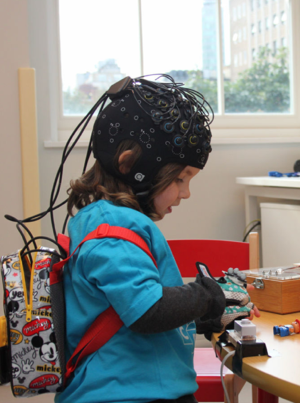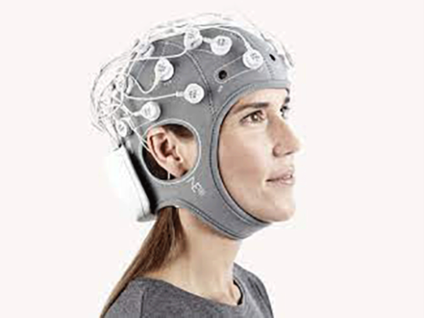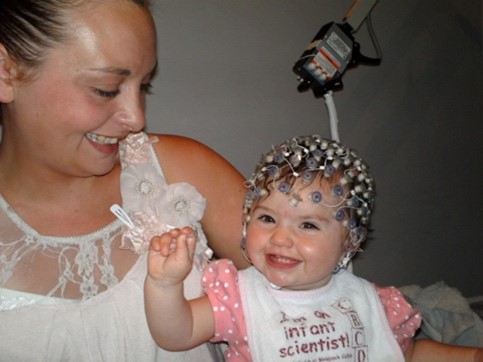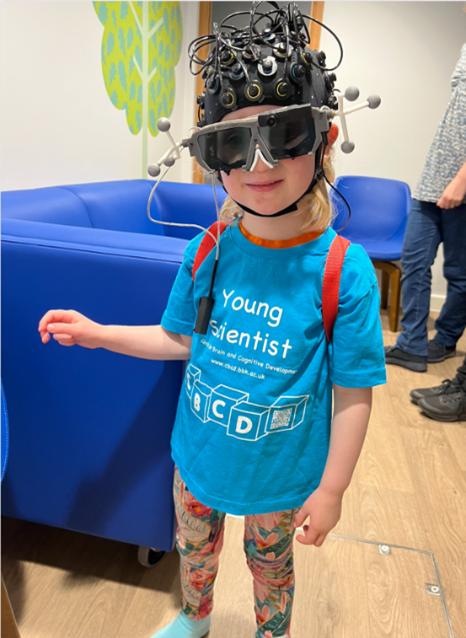The ToddlerLab is equipped with cutting-edge technologies, both wearable and lab-based, that allows to measure with high precision the behavioral, physiological, and neural signatures in toddlers and preschoolers.
 Neuroimaging equipment
Neuroimaging equipment
- Wearable functional Near Infrared Spectroscopy (fNIRS) – 2 x Brite MKII by Artinis
- Wearable Electroencephaloghraphy (EEG) – 2 x Enobio 20 by Neuroelectrics
- Lab-based broadband Near Infrared Spectroscopy (bNIRS) – Custom made by Prof. Ilias Tachtsidis from University College London (UCL).
- Lab-based Electroencephaloghraphy (EEG) – Geodesic EEG system by MagstimEGI
Eye-tracking
- Screen-based eye-tracking – Eyelink 1000+ by SR-Research
- Head-mounted eye-tracking – 10 x Pupil Core by Pupil Labs
Motion tracking
Motion tracking cameras – Vero by Vicon
Physiological monitoring system
- Heart rate, Respiration rate, Galvanic Skin Response – MP160 by Biopac
Audiovisual Equipment
CAVE – VR CAVE system by Mechdyne
- Video cameras
- Interactive whiteboard by Promethean
- Projector
- TV
Wearable functional Near Infrared Spectroscopy (fNIRS) – Brite MKII (Artinis)
The Brite MKII is a user-friendly, continuous-wave wearable NIRS device equipped with 10 light sources and 8 detectors. The Brite MKII comes with a multi-power gain control. This feature enables users to measure at 4 different power levels and auto-power settings per channel, enabling optimal data quality across a wide range of ages, skin color, hair type and cortical optode distances.
Two Brite MKII devices are available that can be used individually (up to 27 measurement channels) or in dual-mode (up to 54 measurement channels).
The Brite MKII system is fully wearable and wireless, allowing the participant to move freely.
For technical specification, visit https://www.artinis.com/brite.
Wearable Electroencephaloghraphy (EEG) – Enobio 20 (Neuroelectrics)
 Mobile, comfortable, precise and robust wireless EEG. Ideal for medium-density recording research applications requiring the full 10-10 system.
Mobile, comfortable, precise and robust wireless EEG. Ideal for medium-density recording research applications requiring the full 10-10 system.
Two Enobio 20 devices are available, with up to 20 channels each and equipped with geltrode electrodes.
For technical specification, visit https://www.neuroelectrics.com/solutions/enobio/20.
Lab-based Electroencephaloghraphy (EEG) – Geodesic EEG system (MagstimEGI)
 Geodesic EEG is EGI’s unique technology designed specifically for whole head EEG. Using 32 to 256 electrodes evenly spaced over the entire scalp, cheeks, and back of the neck, Geodesic EEG provides dense and even sampling, ad nallows to detect brain activity at high spatial resolution, without having to interpolate between widely spaced sensors.
Geodesic EEG is EGI’s unique technology designed specifically for whole head EEG. Using 32 to 256 electrodes evenly spaced over the entire scalp, cheeks, and back of the neck, Geodesic EEG provides dense and even sampling, ad nallows to detect brain activity at high spatial resolution, without having to interpolate between widely spaced sensors.
For technical specification, visit https://www.egi.com/research-division/eeg-systems/geodesic-eeg-systems.
Screen-based eye-tracking – Eyelink 1000+ (SR-Research)
The EyeLink 1000 Plus is a video-based eye tracking system equipped with several camera mounting options (e.g., Desktop Mount, Arm Mount) specialized to optimize particular eye-tracking tasks. The EyeLink 1000 Plus camera has been designed specifically for eye tracking and interchangeably fits into different mounts that illuminate the eyes and position the camera in different ways to allow a flexible range of applications
For technical specification, visit https://www.sr-research.com/eyelink-1000-plus/.
Head-mounted eye-tracking –Pupil Core (Pupil Labs)
 Pupil Core is an eye tracking platform that is comprised of an open source software suite and a wearable eye tracking headset.
Pupil Core is an eye tracking platform that is comprised of an open source software suite and a wearable eye tracking headset.
Pupil Core comes with a child-size headset for eye-tracking only studies.
For multimodal studies integrating eye-tracking with head-tracking and/or the CAVE, we have in-house built and 3D printed a child-sized headset combining all the techniques and sensors.
Motion tracking cameras – Vero (Vicon)
 Vero motion tracking cameras’ super-wide field of view and compact build allow to capture fast-moving participants with very low latency and at high resolution (up to 250 FPS).
Vero motion tracking cameras’ super-wide field of view and compact build allow to capture fast-moving participants with very low latency and at high resolution (up to 250 FPS).
Thanks to their variable-focus lens and powerful strobes, these cameras are very flexible and perform well whatever the size and shape of the room and also in case of full-body tracking at short range. Motion tracking cameras shine infrared light which is reflected by markers that can be placed at any location on the participant’s body. Hence, it is a contact-less technique and highly suitable for children.
CAVE – VR CAVE system (Mechdyne)
 The CAVE is an immersive and interactive virtual reality system consisting of a cubic room within a darkened space in which the floor and the side and front walls of the cube are projection screens where virtual scenes are displayed. The size of the CAVE is 4.3 x 2 x 3.2 m.
The CAVE is an immersive and interactive virtual reality system consisting of a cubic room within a darkened space in which the floor and the side and front walls of the cube are projection screens where virtual scenes are displayed. The size of the CAVE is 4.3 x 2 x 3.2 m.
Four motion tracking cameras (Vicon) are placed on the corners of the room to track participants’ movements with high precision as they move freely in that space and provide interaction between participants and the CAVE. Through motion tracking reflective markers, children are able to motion tracking markers i.e. walk around the virtual space, grasp and move objects, look around, etc.
The CAVE is equipped with an active shutter 3D system for displaying stereoscopic 3D virtual scenarios. This is accomplished via LCD shutter glasses (Volfoni). Given that child-sized shutter glasses are not commercially available, we have in-house built and 3D printed a child-sized headset incorporating the LCD shutter lenses. Participants can thus wear shutter glasses for full 3D immersive experience.
Virtual scenes must be developed using Unity and must be integrated with the Mechdyne proprietary Unity plug-in (getReal3D; https://www.mechdyne.com/software-services/software-solutions/getreal3d-for-unity/) to be run and projected in the CAVE. Email Dr. Paola Pinti (p.pinti@bbk.ac.uk). for further information.
Visit https://www.mechdyne.com/ for further information.
